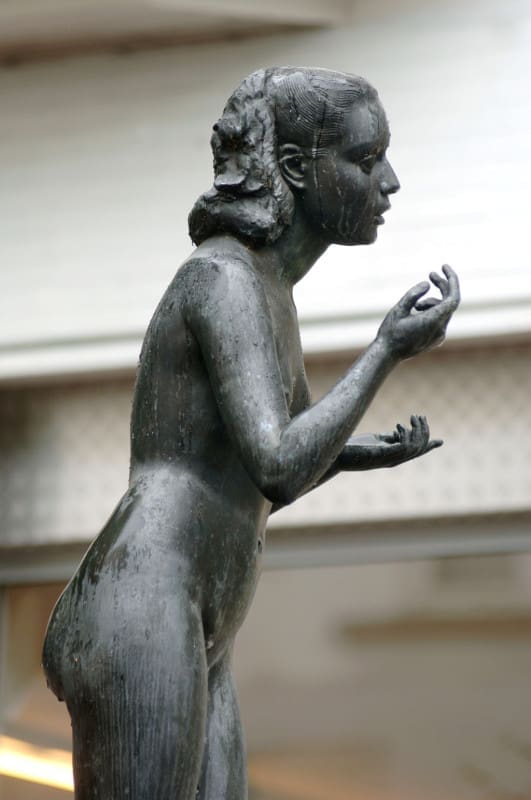ZANGERTJE (LODE EYCKERMANS)
In the immediate vicinity of ‘Najade’ (Alphonse Darville) the street is embellished by the statues, ‘Zangertje (Little Singer)’ -1942- and ‘Tine’ -1960. Comparing these statues gives an interesting insight in the evolution of style.
‘Zangertje’ is all purity and simplicity. The single decorative accent in the hairdo emphasises the frail nudity. The singing girl bends slightly forward and accompanies her voice with the subtle play of her hands. She is fully concentrated on intoning the music. The artist succeeds in suggesting the bronze singing.
Both ‘Zangertje’ and ‘Tine’ were presented to the city of Sint-Niklaas by Lode Eyckermans, their creator.‘Zangertje’ made in 1942, originally belonged to the sculptural group ‘De vier Jaargetijden (The four seasons)’. Other works of Eyckermans are on show in Wilrijk, Willebroek, Mechelen, De Haan and Barvaux.
Tormented by hatred because of his war captivity during the second World War, in his work Eyckermans focussed on the theme of love, whereby he did not shun erotic expressions.
Originally Eyckermans created mainly realistic, solitary figures in a typical classic posture.
His work also includes subjects as death, mother and child and self-portraits. In 1952 Eyckermans worked for some months in Italy. There he met Henry Moore, whose work clearly influenced him. This is apparent in his subsequent works.
In the seventies Eyckermans reverts to solitary figures, albeit in a more abstract design, sometimes with humour and sarcasm. Later he evolved towards a stylised, futuristic style, maintaining however the organic aesthetics.
EYCKERMANS Lode (1919-1998)
Born and deceased in Antwerpen. Schooled by Frans Huygelen and Ernest Wijnants at the Higher Institute of Antwerpen. Becomes a teacher at the Academies of Antwerpen and Mechelen in 1949. From 1975 to 1983 he is head of the Academy for Free Visual Arts in Mechelen. His first important exphibition is the Quadrennial in Liège in 1939. He wins several awards, among which the ‘Grote Prijs van de stad Antwerpen’ (1936); the 'Van Leriusprijs’ for sculpture (1941); the 'Godecharleprijs' (1942) and the ‘Prijs van Rome’ (1943), this last award gives him the opportunity to go and work in Rome for a year.
Kunst in de Stad – June 15th 1991

